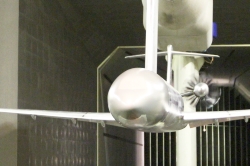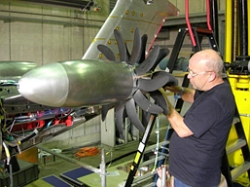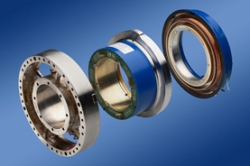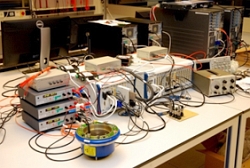
CROR model in the DNW-LLF
Late January 2013, Airbus successfully completed an extensive test campaign in the DNW-LLF wind tunnel under the European Clean Sky program.
Worldwide a large demand for more economical aircraft exists, for environmental reasons as well as the need for airlines to improve their profitability. All aircraft and engine manufacturers are investing in more economical gas turbines and improved propulsion on aircraft. The next generation of aircraft will consume less fuel, thanks to new gas turbines or a new entrant: the “Counter Rotating Open Rotor” (CROR).
As the demand for more economical aircraft will remain high in the near and distant future, research is conducted into the next generation of aircraft in two Integrated Technology Demonstrators of the European Clean Sky program. Application of a CROR will have to further reduce fuel consumption for these aircraft. A CROR has two series-mounted rotors which rotate in opposite directions.

Adjusting the CROR model
Purpose of the second rotor is to undo the rotating motion of the air originating from the first rotor. In addition, the propulsion efficiency of a CROR is high due to its high by-pass ratio. A point of attention for the CROR is rotor noise, especially during takeoff and landing. In the European Clean Sky program the step by step research conducted will possibly lead to introduction of CROR propulsion on passenger aircraft. A first step in the development is theoretical work, the second wind tunnel measurements. For measurements in the low-speed range the DNW-LLF has been selected.
The test
The test campaign was launched in April 2012 and consisted of three test programs. The first test was performed with the engine in the LLF open test section. The second (Handling Quality) test took place on the complete model (aircraft plus engine) in the closed test section. The third test was executed with the complete model in the ‘open test section’. The measurements took hundreds of hours and resulted in many terabytes of data.

CROR balance and telemetry unit
The CROR wind tunnel model
The CROR wind tunnel model is designed by Airbus in cooperation with NLR and DNW. The model is a complete aircraft scale 1:7 with two air-powered engines. For these engines, with a maximum of 8400 rpm, Airbus designed and built the air motor. NLR designed and produced the composite propellers and rotating measuring balances. Besides propeller blades for the Airbus model, also propeller blades are designed for other engine manufacturers.
Telemetry Units
NLR designed and built rotating Telemetry Units. These Telemetry Units measure and digitize the sensor signals on forces, temperatures and pressures in the blades and balances. The measured data is transferred contactless from the rotating part to the fixed part.

CROR Model Instrumentation System
Model instrumentation system
Besides the Telemetry Units, NLR developed an acoustic measurement system with components in and outside the model. Sensors in the propeller blades were also part of this acoustic measurement system. The measurement of the data of the connected pressure sensors and microphones took place with a high degree of synchronization (deviation less than 1 microsecond). The Model Instrumentation System comprised the entire chain of data acquisition, processing and registration. An Operator Station provided the test specialists with an impression of the measurement results and allowed for monitoring of critical parameters.
Epilogue
All stakeholders are proud of the fact that the test campaign was very successful. The follow-up is now in the hands of (acoustic) specialists from Airbus and the engine manufacturers. Their first challenge lies now in interpreting the many Terabytes of data.
The results are of great importance for further development of the CROR concept in Clean Sky 2.
Also visit our Avionics Development, Wind tunnel models, Wind tunnel equipment and Flight Physics capability pages.

